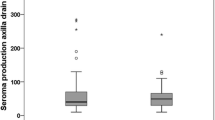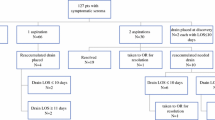Abstract
Background
Despite a trend for less radical surgical approaches in breast cancer due to better understanding of tumour biology and new treatment options such as neoadjuvant chemotherapy (NAC) and intra-operative radiotherapy (IORT), seroma production remains one of the main surgical side effects that can result in prolonged recovery, delay of radiotherapy and patient discomfort. The aim of this study is to provide an update on risk factors for seroma production after breast cancer surgery considering the latest treatment options.
Methods
A retrospective analysis of seroma production in primary breast cancer patients treated between 01.01.2010 and 31.12.2014 at the Breast Cancer Centre, University Hospital Ulm, was performed. Patients with previous breast/axillary surgery or more than one intervention were excluded. Seroma formation was measured using wound drains placed in breast and axilla.
Results
In total, 581 patients met the inclusion criteria. Median age at diagnosis was 60 years, and median BMI 25.6 kg/m2. 60 (10.3%) patients had a mastectomy, 175 (30.1%) patients received IORT, and 72 (12.4%) patients received NAC. Median amount of seroma production was 82.5 ml (range 0–3012.5 ml). Multivariate analysis revealed that most of the observed variation in seroma production was due to type of surgery (mastectomy vs. breast conserving), length of surgery and number of removed lymph nodes. Both NAC and IORT explained a significant but very small amount of the observed variation in seroma production.
Conclusion
The most important factors for seroma production are extent and duration of breast surgery.



Similar content being viewed by others
References
Veronesi U, Luini A, Galimberti V, Zurrida S (1991) Conservation approaches for the management of stage I/II carcinoma of the breast: Milan Cancer Institute trials. World J Surg 18(1):70–75
Abt NB, Flores JM, Baltodano PA, Sarhane KA, Abreu FM, Cooney CM et al (2014) Neoadjuvant chemotherapy and short-term morbidity in patients undergoing mastectomy with and without breast reconstruction. JAMA Surg 149(10):1068–1076
Sedlmayer F, Sautter-Bihl M-L, Budach W, Dunst J, Fastner G, Feyer P et al (2013) DEGRO practical guidelines: radiotherapy of breast cancer I: radiotherapy following breast conserving therapy for invasive breast cancer. Strahlenther Onkol 189(10):825–833
Boostrom SY, Throckmorton AD, Boughey JC, Holifield AC, Zakaria S, Hoskin TL et al (2009) Incidence of clinically significant seroma after breast and axillary surgery. J Am Coll Surg 208(1):148–150
Silverstein MJ, Fastner G, Maluta S, Reitsamer R, Goer DA, Vicini F et al (2014) Intraoperative radiation therapy: a critical analysis of the ELIOT and TARGIT trials. Part 2–TARGIT. Ann Surg Oncol 21(12):3793–3799
Buchholz TA, Somerfield MR, Griggs JJ, El-Eid S, Hammond MEH, Lyman GH et al (2014) Margins for breast-conserving surgery with whole-breast irradiation in stage I and II invasive breast cancer: American Society of Clinical Oncology endorsement of the Society of Surgical Oncology/American Society for Radiation Oncology consensus guideline. J Clin Oncol 32(14):1502–1506
Kreienberg R, Kopp I, Albert U-S, Bartsch HH, Beckmann MW, Berg D et al (2012) Interdisziplinäre S3-Leitlinie und Nachsorge des Leitlinie. Ger Cancer Soc 2012(7):32–45
Srivastava V, Basu S, Shukla VK (2012) Seroma formation after breast cancer surgery: what we have learned in the last two decades. J Breast Cancer 15(4):373–380
Kuroi K, Shimozuma K, Taguchi T, Imai H, Yamashiro H, Ohsumi S et al (2006) Evidence-based risk factors for seroma formation in breast surgery. Jpn J Clin Oncol 36(4):197–206
Purushotham AD, Upponi S, Klevesath MB, Bobrow L, Millar K, Myles JP et al (2005) Morbidity after sentinel lymph node biopsy in primary breast cancer: results from a randomized controlled trial. J Clin Oncol 23(19):4312–4321
Ebner FK, Friedl TWP, Reich A, Janni W, Rempen A, Degregorio N et al (2013) Does non-placement of a drain in breast surgery increase the rate of complications and revisions? Geburtshilfe Frauenheilkd 73(11):1128–1134
Garbay J-R, Thoury A, Moinon E, Cavalcanti A, Di Palma M, Karsenti G et al (2012) Axillary padding without drainage after axillary lymphadenectomy—a prospective study of 299 patients with early breast cancer. Breast Care (Basel) 7(3):231–235
Taylor JC, Rai S, Hoar F, Brown H, Vishwanath L (2013) Breast cancer surgery without suction drainage: the impact of adopting a “no drains” policy on symptomatic seroma formation rates. Eur J Surg Oncol 39:334–338
Thomson DR, Sadideen H, Furniss D (2013) Drainage tube placement after lymph gland removal from the armpit for breast cancer. Wiley, New York
Glechner A, Wöckel A, Gartlehner G, Thaler K, Strobelberger M, Griebler U et al (2013) Sentinel lymph node dissection only versus complete axillary lymph node dissection in early invasive breast cancer: a systematic review and meta-analysis. Eur J Cancer 49:812–825
Joyce DP, Manning A, Carter M, Hill ADK, Kell MR, Barry M (2015) Meta-analysis to determine the clinical impact of axillary lymph node dissection in the treatment of invasive breast cancer. Breast Cancer Res Treat 153:235–240
Shah-Khan M, Boughey JC (2012) Evolution of axillary nodal staging in breast cancer: clinical implications of the ACOSOG Z0011 trial. Cancer Control 19(4):267–276
Janni W, Kühn T, Schwentner L, Kreienberg R, Fehm T, Wöckel A (2014) Sentinel node biopsy and axillary dissection in breast cancer: the evidence and its limits. Dtsch Arztebl Int 111(14):244–249
Ebner F, Wöckel A, Janni W, Kreienberg R, Schwentner L, Wischnewsky M (2017) Personalized axillary dissection: the number of excised lymph nodes of nodal-positive breast cancer patients has no significant impact on relapse-free and overall survival. J Cancer Res Clin Oncol 143:1823–1831
Balakrishnan A, Ravichandran D (2011) Early operable breast cancer in elderly women treated with an aromatase inhibitor letrozole as sole therapy. Br J Cancer 105(12):1825–1829
Hille U, Soergel P, Länger F, Schippert C, Makowski L, Hillemanns P (2002) Aromatase inhibitors as solely treatment in postmenopausal breast cancer patients. Breast J 18(2):145–150
Hind D, Wyld L, Reed MW (2007) Surgery, with or without tamoxifen, vs tamoxifen alone for older women with operable breast cancer: Cochrane review. Br J Cancer 96(7):1025–1029
Headon H, Wazir U, Kasem A, Mokbel K (2016) Surgical treatment of the primary tumour improves the overall survival in patients with metastatic breast cancer: a systematic review and meta-analysis. Mol Clin Oncol 4(5):863–867
Cortadellas T, Córdoba O, Espinosa-Bravo M, Mendoza-Santin C, Rodríguez-Fernández J, Esgueva A et al (2011) Electrothermal bipolar vessel sealing system in axillary dissection: a prospective randomized clinical study. Int J Surg 9(8):636–640
Manouras A, Markogiannakis H, Genetzakis M, Filippakis GM, Lagoudianakis EE, Kafiri G et al (2008) Modified radical mastectomy with axillary dissection using the electrothermal bipolar vessel sealing system. Arch Surg. 143(6):575–580 (discussion 581)
Nespoli L, Antolini L, Stucchi C, Nespoli A, Valsecchi MG, Gianotti L (2012) Axillary lymphadenectomy for breast cancer. A randomized controlled trial comparing a bipolar vessel sealing system to the conventional technique. Breast 21(6):739–745
Canavese G, Catturich A, Vecchio C, Gipponi M, Tomei D, Sertoli MR et al (1997) Surgical complications related to peri-operative adjuvant chemotherapy in breast cancer. Results of a prospective, controlled, randomized clinical trial. Eur J Surg Oncol 23(1):10–12
Kraus-Tiefenbacher U, Welzel G, Brade J, Hermann B, Siebenlist K, Wasser KS et al (2010) Postoperative seroma formation after intraoperative radiotherapy using low-kilovoltage X-rays given during breast-conserving surgery. Int J Radiat Oncol Biol Phys 77(4):1140–1145
Tuschy B, Berlit S, Romero S, Sperk E, Wenz F, Kehl S et al (2013) Clinical aspects of intraoperative radiotherapy in early breast cancer: short-term complications after IORT in women treated with low energy X-rays. Radiat Oncol 8:95
Ebner F, Schramm A, Bottke D, Friedl TW, Wiegel T, Fink V et al (2016) Comparison of seroma production in breast conserving surgery with or without intraoperative radiotherapy as tumour bed boost. Arch Gynecol Obstet 294:861–866
Cracco S, Semprini G, Cattin F, Gregoraci G, Zeppieri M, Isola M et al (2015) Impact of intraoperative radiotherapy on cosmetic outcome and complications after oncoplastic breast surgery. Breast J 21(3):285–290
Funding
No external or additional funding was used for this study.
Author information
Authors and Affiliations
Contributions
FE: conceptualization, writing original draft, review and editing. TWPF: data curation, formal analysis. AG: resources. KL: supporting. IB: validation. WJ: supervision. NG: conceptualization, review and editing.
Corresponding author
Ethics declarations
Conflict of interest
All authors declare that they have no potential conflict of interest.
Ethical approval
This study was approved by the local ethic committee.
Rights and permissions
About this article
Cite this article
Ebner, F., Friedl, T.W.P., de Gregorio, A. et al. Seroma in breast surgery: all the surgeons fault?. Arch Gynecol Obstet 298, 951–959 (2018). https://doi.org/10.1007/s00404-018-4880-8
Received:
Accepted:
Published:
Issue Date:
DOI: https://doi.org/10.1007/s00404-018-4880-8




